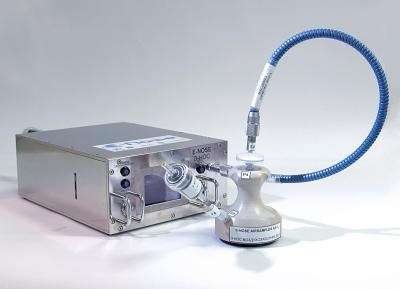Mon, Dec 17, 2012
Astrium Instrument To ‘Sniff Out’ Dangers To Health Of ISS Crew
When the next crew of the International Space Station (ISS) sets off into space aboard a Soyuz spacecraft on December 19, their luggage will contain an electronic nose developed by Astrium. This ‘E-Nose’, as it is called, will measure the crew’s exposure to bacteria and fungi in the Russian segment of the space station from 2013.

E-Nose will detect microbiological hazards from bacterial and fungal cultures using qualitative and quantitative methods. Monitoring is essential as excessive exposure to fungi and bacteria poses a not inconsiderable risk to both the on-board technology and the health of the crew. This specially developed analytical instrument allows cosmonauts to carry out measurements in every location of the ISS Service Module. Also in the luggage will be a ‘target book’ containing various material samples (aluminium, PCB material, cable marking material, and Nomex, a special flame-resistant clothing material which is used to make the suits worn by fire fighters and racing drivers). Biological cultures can colonize these materials. Their presence will be measured by the cosmonauts at two-month intervals. On completion of a measurement cycle lasting about six months, the target book will be sent back to Earth, where the samples will be evaluated by the Moscow-based Institute for Biological and Medical
Problems (IBMP) in cooperation with EADS Innovation Works, the corporate research organization of EADS.
The measurement system built by Astrium is called an electronic nose because it records specific odour patterns using ten different semiconductor sensors. The system takes advantage of the distinctive properties of the gas molecules emitted by the biological cultures. These molecules are produced by the metabolisms of the biological cultures, and are species-specific. Scientists in the laboratory down on Earth can create specific odour patterns based on the different ways in which individual sensors are stimulated. The data measured on the space station will then be compared against the data from the cultures ‘trained’ on Earth in order to find correlations.
The conventional sampling method (swipe sample) with subsequent ‘processing’ in an incubator would require expert knowledge and be very time-consuming in the ISS, whereas the new E-Nose enables a prompt analysis of the situation thanks to its data connection to the ground station.
“In the long run, the E-Nose will make an important contribution to ensuring the safety of the crew on board the ISS. This applies both to the entire space station and also to possible long-term missions (e.g. to Mars),” says Astrium project manager Thomas Hummel. There are also potential applications for the E-Nose down on Earth, e.g. on commercial passenger aircraft or submarines.
E-Nose is a German Aerospace Center (DLR) project, with Astrium as prime contractor.
(Image provided by Astrium)
More News
Also: Vertical Flight Society, NBAA Maintenance Conference, GA Honored, AMT Scholarship For the first time, students from Embry-Riddle’s Daytona Beach, Florida, campus took t>[...]
Hazardous Weather Information Summary of significant meteorological information (SIGMET/WS), convective significant meteorological information (convective SIGMET/WST), urgent pilot>[...]
"The need for innovation at speed and scale is greater than ever. The X-62A VISTA is a crucial platform in our efforts to develop, test and integrate AI, as well as to establish AI>[...]
(FAA) Inspector Observed That Both Fuel Tanks Were Intact And That Only A Minimal Amount Of Fuel Remained In Each Analysis: According to the pilot, approximately 8 miles from the d>[...]
“Pyka’s Pelican Cargo is unlike any other UAS solution on the market for contested logistics. We assessed a number of leading capabilities and concluded that the Pelica>[...]
 Airborne-Flight Training 05.09.24: ERAU at AIAA, LIFT Diamond Buy, Epic A&P
Airborne-Flight Training 05.09.24: ERAU at AIAA, LIFT Diamond Buy, Epic A&P ANN's Daily Aero-Term (05.07.24): Hazardous Weather Information
ANN's Daily Aero-Term (05.07.24): Hazardous Weather Information Aero-News: Quote of the Day (05.07.24)
Aero-News: Quote of the Day (05.07.24) NTSB Final Report: Cessna 150
NTSB Final Report: Cessna 150 Aero-News: Quote of the Day (05.08.24)
Aero-News: Quote of the Day (05.08.24)



